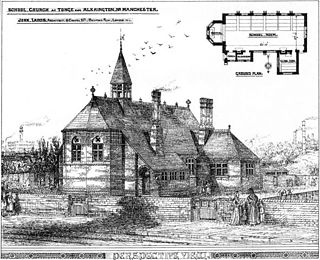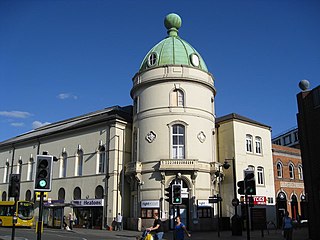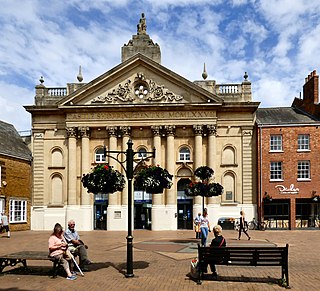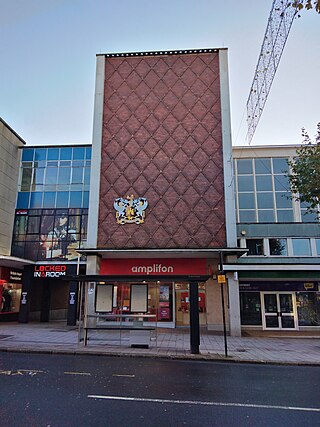
The Leeds Corn Exchange is a shopping mall in Leeds, West Yorkshire, England. The structure, which was commissioned as a corn exchange, is a grade I listed building.

The Hazlitt Theatre and Exchange Studio, also known as the Hazlitt Arts Centre, is a theatre complex in Earle Street in Maidstone, Kent, England. The oldest part of the complex, which is now used as a shopping complex on the ground floor, and as a theatre venue known as the "Exchange Studio" on the first floor, is a Grade II listed building.

The Corn Exchange is an events and concert venue located on St Paul's Square in the Castle area of Bedford, Bedfordshire, England. The structure, which was commissioned as a corn exchange, is a Grade II listed building.

Leicester Corn Exchange is a commercial building in the Market Place in Leicester, Leicestershire, England. The structure, which currently operates as a public house, is a grade II* listed building.

The Edinburgh Corn Exchange is an events and concert venue located in New Market Road in Edinburgh, Scotland. The structure, which was commissioned as a corn exchange, is a Category B listed building.

John Ladds, RIBA, was an architect best known for his work on churches and schools, very often church-affiliated schools.

The Corn Exchange is a commercial building on The Payment in St Ives, Cambridgeshire, England. The structure, which is currently used as an events venue, is a Grade II listed building.

Corn exchanges are distinct buildings which were originally created as a venue for corn merchants to meet and arrange pricing with farmers for the sale of wheat, barley, and other corn crops. The word "corn" in British English denotes all cereal grains, such as wheat and barley. With the repeal of the Corn Laws in 1846, a large number of corn exchanges were built in England, particularly in the corn-growing areas of Eastern England.

Wisbech Town Hall is an historic building on North Brink, Wisbech, Isle of Ely, Cambridgeshire, England. The building incorporates the offices, council chamber and mayor's parlour of Wisbech Town Council, and is a Grade II listed building.

The Corn Exchange is a commercial building in King Street in Ipswich, Suffolk, England. The structure, which is currently used as a public events venue, is Grade II listed building.

The Corn Exchange is a commercial building in Abbeygate Street in Bury St Edmunds, Suffolk, England. The structure, which is currently used as a public house, is a Grade II listed building.

The Corn Exchange is a commercial building on Fore Street in Hertford, Hertfordshire, England. The structure, which is currently used as an events venue, is a Grade II listed building.

The Corn Exchange is a commercial building in Albert Street in Derby, Derbyshire, England. The structure, which is currently used as an indoor sports venue, is a Grade II listed building.

The Corn Exchange is a former commercial building in Preston, Lancashire, England, which was commissioned as a corn exchange and later used for 90 years as an assembly room and auditorium known as the Public Hall. Much of the structure was demolished in the late 1980s, but the main entrance building survives as a public house, and is a Grade II listed building.

The Corn Exchange is a commercial building in Tuesday Market Place, King's Lynn, Norfolk, England. The structure, which was commissioned as a corn exchange and is now used as an events venue, is a Grade II listed building.

The Cornhill Corn Exchange was a commercial building in the Market Place, Banbury, Oxfordshire, England. The remaining part of the structure, which has been largely demolished, but the façade of which is now used as an entrance to a shopping centre, is a Grade II listed building.

The Corn Exchange is a commercial building in the St Catherine Street, Cupar, Fife, England. The structure, which is now used as a community events venue, is a Category B listed building.

The Corn Exchange is a market hall and events venue in the Market Street, Exeter, Devon, England. It was designed by the city architect, Harold Rowe and completed in 1960.

The Corn Exchange is a commercial building in Gloucester Street in Faringdon, Oxfordshire, England. The structure, which is currently used as a community events venue, is a Grade II listed building.

The Corn Exchange is a commercial building in Withersfield Road in Haverhill, Suffolk, England. The structure, which is currently vacant and deteriorating, is a Grade II listed building.






















